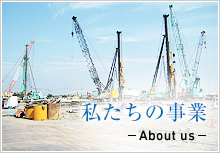2007.08.01
Pile Loading Tests at Osaka Amenity Park Project(1992)
H.Kishida(Tokyo Institute of Technology)・Y.Tsubakihara(Tokyo Institute of Technology)・H.Ogura(GEOTOP)
■掲載誌:2nd International Conference on DEEP FOUNDAITON PRACTICE Incorporating PILETALK 1992
■発行所:
■発行:1992/11
Three kinds of pile loading tests were conducted at Osaka Amenity Park Project. The sizes of the instrumented test piles were 38.5 m in length and 1.2 m in diameter. The out]ine of each test was as follows. (1) Vertical loading test: Vertical load of 19.6 MN (2,000 tO was applied to the top of one pile. Friction cut had been done for the pile surface from ground surface to the depth of 17 m. (2) Pulling tests: Pulling forces of 4.9 MN (500 tO and 9.8 MN (1,000 tO were app]ied to the top of one pile. The pile was used as one of four anchor piles for [he vertical loading test. The first force of 4.9 MN (= 19.6 MN / 4) was a reatction force. The second force of 9.8 MN was applied to obtain the ultimate pulling resistance. (3) Simplified loading tests: A pair of upward and downward forccs of about 7.84 MN (80O tD was applied to the bottoms of two piles. Fric[ion cut had been done for [he surface of one pile from ground surface to the depth of 17 m. The mutua]Iy opposite forces were obtained by expanding the cell of a jack placed at the bottom of the pi]e. Skin friction and end bearing vere separated by the jack. No anchor pile and no reaction beam were needed for conducting the tests. The vord of 'simplified' is derived from the simplicity of the test. In all tests mentioned above the distribution of axial load and the displacemcnts of the top and bottom of the pile vere measured. The information obtained was as follows. (1) The relationships between skin friction and pi]e displacement in two simplified loading tests were in good agreement with that in the vertical loading test at each pile section. (2) The relationships between pile tip resistance and settlement in two simplified loading tests were in good agreement with that in the vertical loading test.
■発行所:
■発行:1992/11
Three kinds of pile loading tests were conducted at Osaka Amenity Park Project. The sizes of the instrumented test piles were 38.5 m in length and 1.2 m in diameter. The out]ine of each test was as follows. (1) Vertical loading test: Vertical load of 19.6 MN (2,000 tO was applied to the top of one pile. Friction cut had been done for the pile surface from ground surface to the depth of 17 m. (2) Pulling tests: Pulling forces of 4.9 MN (500 tO and 9.8 MN (1,000 tO were app]ied to the top of one pile. The pile was used as one of four anchor piles for [he vertical loading test. The first force of 4.9 MN (= 19.6 MN / 4) was a reatction force. The second force of 9.8 MN was applied to obtain the ultimate pulling resistance. (3) Simplified loading tests: A pair of upward and downward forccs of about 7.84 MN (80O tD was applied to the bottoms of two piles. Fric[ion cut had been done for [he surface of one pile from ground surface to the depth of 17 m. The mutua]Iy opposite forces were obtained by expanding the cell of a jack placed at the bottom of the pi]e. Skin friction and end bearing vere separated by the jack. No anchor pile and no reaction beam were needed for conducting the tests. The vord of 'simplified' is derived from the simplicity of the test. In all tests mentioned above the distribution of axial load and the displacemcnts of the top and bottom of the pile vere measured. The information obtained was as follows. (1) The relationships between skin friction and pi]e displacement in two simplified loading tests were in good agreement with that in the vertical loading test at each pile section. (2) The relationships between pile tip resistance and settlement in two simplified loading tests were in good agreement with that in the vertical loading test.

